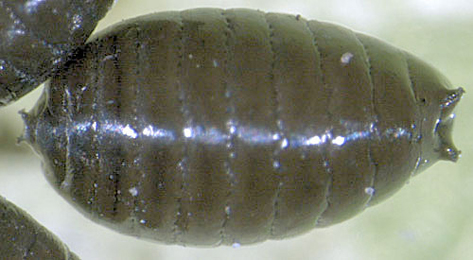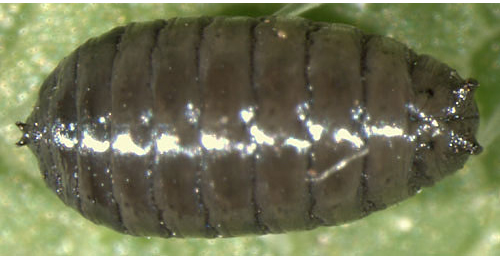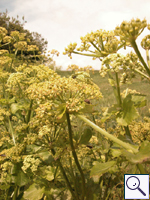|
||||||
|
PASTINACA. Wild parsnip. [Apiaceae] |
|
|
Three species of Pastinaca are recorded in Britain. These include the native Wild Parsnip (P. sativa). Eight or nine British miners are recorded on Pastinaca. A key to the European miners recorded on Pastinaca is provided in Bladmineerders van Europa. |
|
Key for the identification of the known mines of British |
1a > Leaf-miner: A large blotch, yellow or brown, preceded by a short corridor that in the end mostly is completely overrun. Generally several larvae share a mine. Especially in fresh mines the green primary and secondary feeding lines are well visible. Pupation outside the mine. Puparium yellow. |
 Euleia heraclei pupariria Image: © Willem Ellis (Bladmineerders van Europa) |
|
Euleia heraclei (Linnaeus, 1758) [Diptera: Tephritidae]. |
1b > Leaf-miner: Mine linear, whitish, both upper and lower surface. Pupation internal, at the end of the mine with the anterior spiracles projecting through the epidermis (Spencer, 1976: 433). Upper-surface, less often lower-surface corridor. Frass in isolated grains. Pupation within the mine, usually in a lower-surface puparial chamber. A long whitish upper surface corridor, which eventually goes lower surface. |
|
| Chromatomyia horticola (Goureau, 1851) [Diptera: Agromyzidae]. |
1c > Leaf-miner: A short linear mine which considerably widens towards the end, normally starting in the centre of the leaf (Spencer, 1972b: 86 (fig. 288); Spencer, 1976: 447). A short, narrow, upper-surface corridor, starting the in the centre of the leaf, that suddenly widens strongly. The widened corridor loosely follows the leaf margin. Frass in irregularly scattered black granules. Primary feeding lines conspicuous. Pupation outside the mine; according to Allen (1956a) the exit slit is in the upper epidermis. |
|
Phytomyza melana Hendel, 1920 [Diptera: Agromyzidae]. |
1d > Leaf-miner: A conspicuous, whitish linear mine. Pupation external (Spencer, 1976: 506, 507 (fig. 886)). Long, upper-surface, frequently branched, little widening corridor; sides somehwat irregular. Often several mines in a leaf. Frass in grains that are placed close together, rarely forming short pearl chains. Pupation outside the mine, exit slit in lower epidermis. Sometime the puparium sticks to the leaf. Feeding punctures in lower epidermis. Larva forms a conspicuous, whitish linear mine. Larva leaves the mine through the lower surface and falls from the leaf on pupation. |
 Phytomyza pastinacae / spondyli puparium Image: © Willem Ellis (Bladmineerders van Europa) |
|
Phytomyza
spondylii Robineau-Desvoidy, 1851 [Diptera: Agromyzidae] |
1e > Leaf-miner: Larva forming an irregular upper surface linear mine, which can widen and become almost blotch like at end (Spencer, 1972b: 78 (fig. 262), 81; Spencer, 1976: 378, 379 (fig. 657)). Upper-surface blotch, often following the leaf margin for some length, finally strongly widened. The real start of the mine, however, is a long narrow epidermal corridor in the lower surface of the leaf, made by the first instar larva (Allen, 1956a). Pupation outside the mine, exit slit generally in the leaf lower epidermis. An upper surface mine, which can widen and form a blotch. |
|
Phytomyza angelicastri Hering, 1923 [Diptera: Agromyzidae]. |
1f > Leaf miner: A regular greenish inter-parenchymal blotch mine, frequently delimited by two veins, appearing somewhat mottled as a result of small deeper areas of feeding through the upper parenchyma (Spencer, 1972b: 78 (fig. 259); Spencer, 1976: 428, 429 (fig. 748). The mine starts with a quite inconspicuous lower-surface corridor that soon changes into an extensive interparenchymatous blotch. The upper cell layer of the palisade parenchyma is eaten away in many places, giving the mine in transparency a perforated appearance. Fresh mines are pale green, later they turn brown; they give the leaves a strikingly diseased impression. Feeding lines absent, frass grains strikingly few. Larvae solitary. Pupation outside the mine, exit slit in lower epidermis. Forms a blotch mine between two veins, having a characteristic sieve-like appearance (where the larva has fed through the upper parenchyma). Pupation outside the mine.. |
 Phytomyza heracleana puparium Image: © Willem Ellis (Bladmineerders van Europa) |
|
Phytomyza heracleana Hering, 1937 [Diptera: Agromyzidae]. |
1g > Leaf-miner: A short, irregular, linear upper surface mine on any part of the leaf. Also recorded from young pods (Bland, 1997a). Long corridor mine. As a rule the first part of the mine is lower-surface, the later part upper-surface. Often the loops are so dense that a secondary blotch is the result. Because upper- and lower-surface corridor segments often cross, the mine obtains a strange array of transparant patches. There is no association with the midrib. Frass in strings and thread fragments. Pupation outside the mine; exit slit in upper epidermis. Mine not associated with the veins or midrib of the leaf (It is this character which enables distinction from another Agromyzid pest species - Liriomyza huidobriensis). The larvae may leave one leaf (if not large enough) and enter another leaf, via the petiole). It exits the leaf to pupate through a semi-circular slit in the upper surface of the leaf. |
|
Liriomyza bryoniae (Kaltenbach, 1858) [Diptera: Agromyzidae]. |
1h > Leaf-miner: The larvae are often gregarious and feed on the underside of the leaf causing a 'windowing' effect as they eat the mesophyll and lower epidermis. This effect can be seen from the top of the leaf as it discolours. Short, small, irregular, sometimes widened corridor. Mostly a number in a leaf, concentrated in the axils of the midrib and the primary side veins. Each larva makes a number of mines. Often the larva protrudes with its rear end out of the mine, causing most frass to be ejected. While moving, at the leaf underside, silken threads are produced, in wich grains of frass may be trapped. Older larvae live free and cause window feeding, often in a group under a light spinning. |
|
Epermenia chaerophyllella (Goeze, 1783) [Lepidoptera: Epermeniidae]. |
| Last updated 06-Jul-2019 Brian Pitkin | ||

